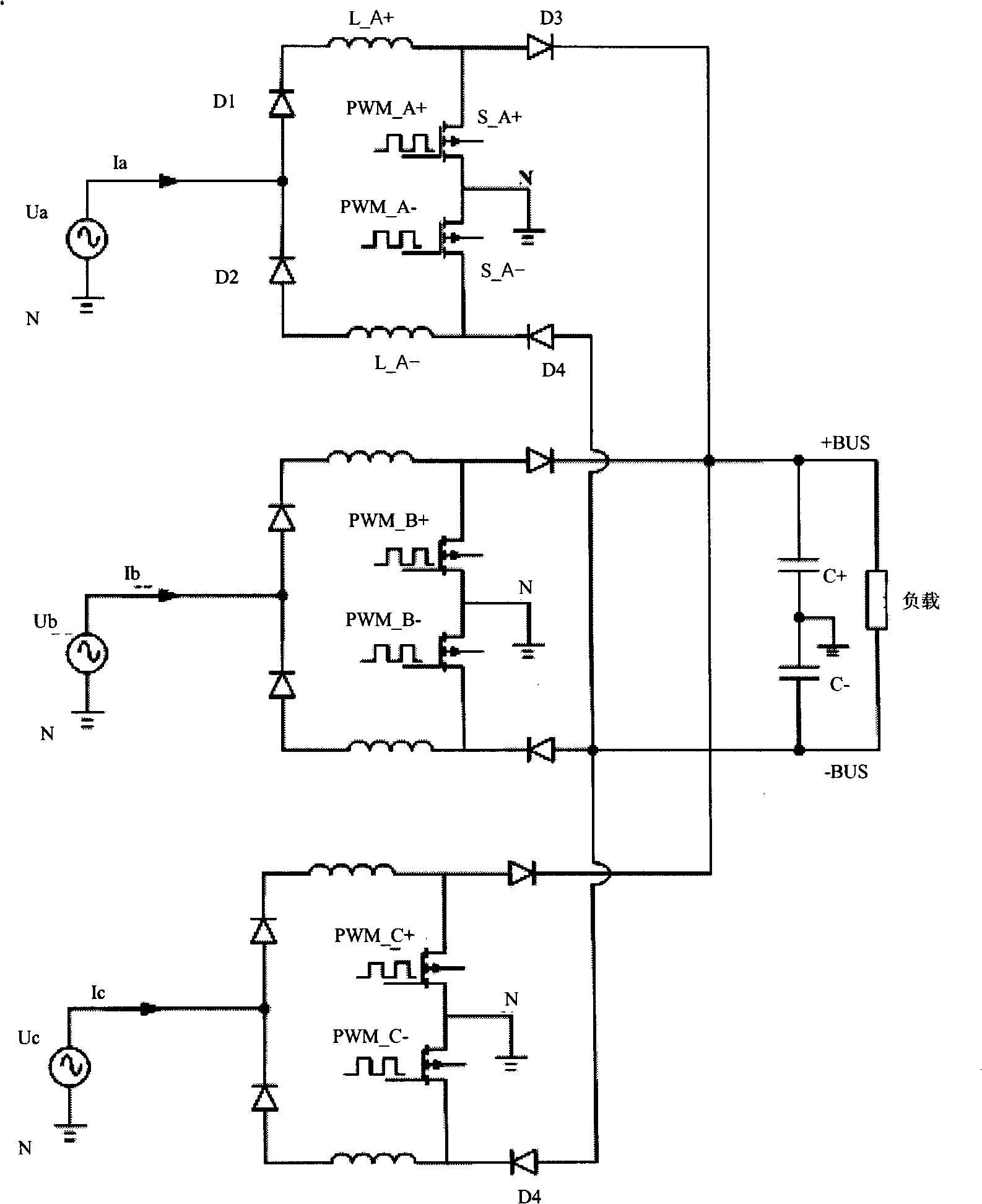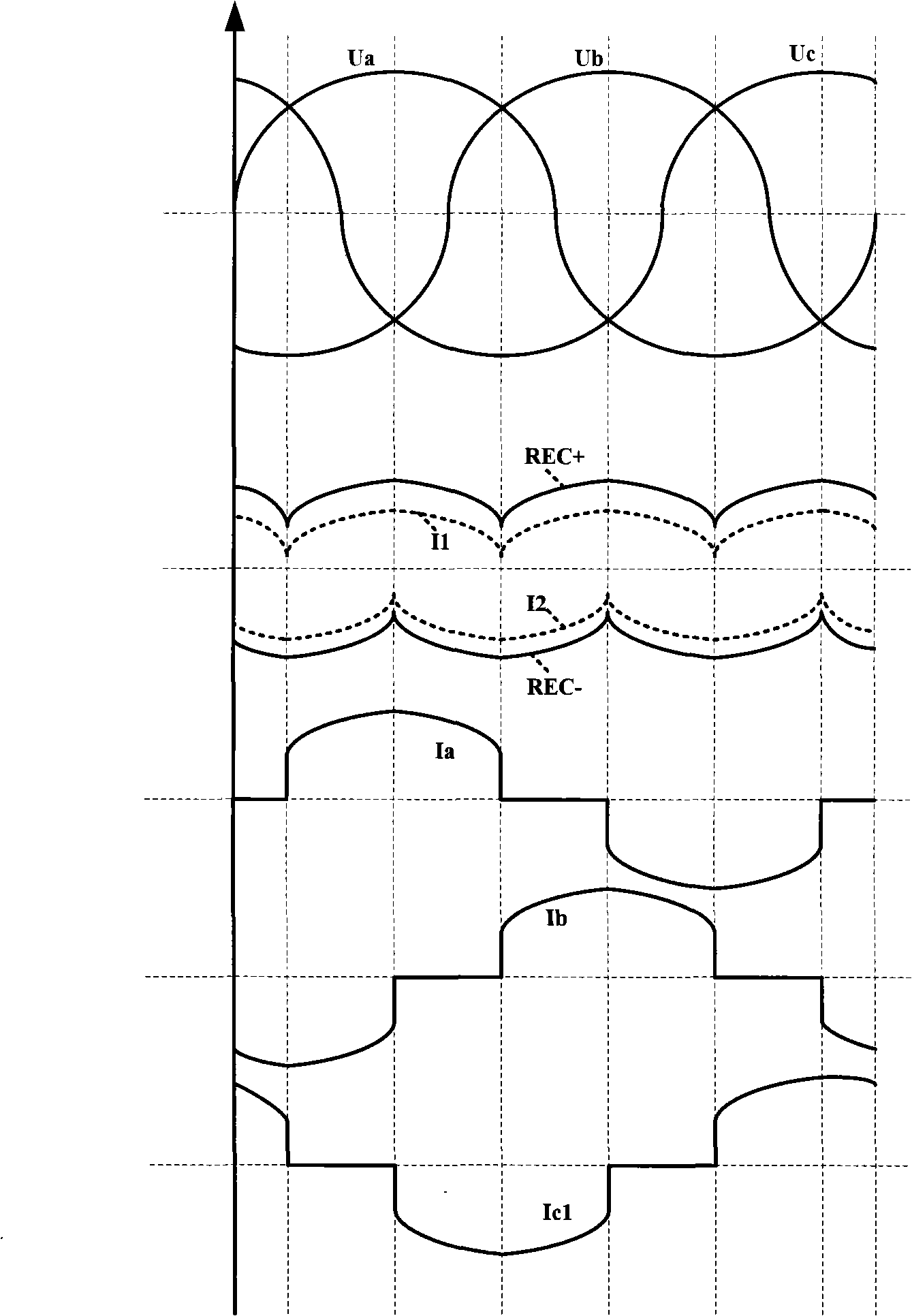Compensating three-phase active power factor correcting circuit
A power factor correction and correction circuit technology, applied in reactive power compensation, reactive power adjustment/elimination/compensation, energy industry, etc. Product performance and market competitiveness, high input power factor and power density, cost reduction effect
- Summary
- Abstract
- Description
- Claims
- Application Information
AI Technical Summary
Problems solved by technology
Method used
Image
Examples
specific Embodiment approach 1
[0034] Such as Figure 4 The shown compensated three-phase active power factor correction circuit includes an uncontrolled three-phase active power factor correction circuit 1, which is a three-phase circuit composed of six diodes DA1, DA2, DB1, DB2, DC1, and DC2. Uncontrolled rectifier bridge, two MOSFET switch tubes S1 and S2 for power conversion, two filter capacitors C1 and C2 respectively connected to the two output terminals of the three-phase uncontrolled rectifier bridge, two boost inductors L1, L2 and two A three-phase double-switch power factor correction circuit with positive and negative output filter capacitors C3, C4 and output diodes D1, D2 respectively connected to both ends of the load. One end of the boost inductor L1, L2 is respectively connected to an output end of the three-phase uncontrolled rectifier bridge, and the other end is respectively connected to one end of the output diode D1, D2.
[0035] There is a three-phase compensation circuit 2-controlla...
specific Embodiment approach 2
[0053] Such as Figure 8 The compensation type three-phase active power factor correction circuit shown is different from the circuit of the specific embodiment 1 in that: the three-phase compensation circuit 2 - the controllable three-phase double-switch power factor correction circuit omits the step-up for power conversion The three input ends of piezoelectric inductors L3 and L4 are respectively connected to one end of three boost inductors L5, L6, and L7, and the other ends of three boost inductors L4, L5, and L6 are respectively connected to three-phase input voltage sources Ua, Ub and Uc are connected. The same compensation function as that of the circuit in Embodiment 1 can also be realized by adding an inductor. Although an inductor is added, the effective value of the current flowing through a single inductor is smaller than that of Embodiment 1, and the volume of the inductor can be smaller under the same inductance value.
specific Embodiment approach 3
[0054] Such as Figure 9 The compensation type three-phase active power factor correction circuit shown is suitable for three-phase input power grid voltage quality is very good, power factor correction without high-frequency interference. The difference from the circuit in Embodiment 1 is: the uncontrolled three-phase active power factor correction circuit 1 and the three-phase compensation circuit 2-the controllable three-phase double-switch power factor correction circuit respectively omits the filter input market Filter capacitors C1 and C2 for electric high-frequency clutter, and filter capacitors C5 and C6. The same compensation function as that of the circuit in the first embodiment can be realized.
PUM
 Login to View More
Login to View More Abstract
Description
Claims
Application Information
 Login to View More
Login to View More - R&D
- Intellectual Property
- Life Sciences
- Materials
- Tech Scout
- Unparalleled Data Quality
- Higher Quality Content
- 60% Fewer Hallucinations
Browse by: Latest US Patents, China's latest patents, Technical Efficacy Thesaurus, Application Domain, Technology Topic, Popular Technical Reports.
© 2025 PatSnap. All rights reserved.Legal|Privacy policy|Modern Slavery Act Transparency Statement|Sitemap|About US| Contact US: help@patsnap.com



